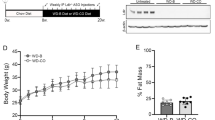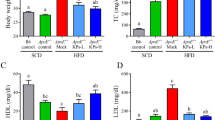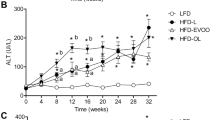Abstract
Objectives
Studies in mice have recently linked increased dietary choline consumption to increased incidence of obesity-related metabolic diseases, while several clinical trials have reported an anti-obesity effect of high dietary choline intake. Since the underlying mechanisms by which choline affects obesity are incompletely understood, the aim of the present study was to investigate the role of dietary choline supplementation in adiposity.
Methods
Female APOE*3-Leiden.CETP mice, a well-established model for human-like lipoprotein metabolism and cardiometabolic diseases, were fed a Western-type diet supplemented with or without choline (1.2%, w/w) for up to 16 weeks.
Results
Dietary choline reduced body fat mass gain, prevented adipocyte enlargement, and attenuated adipose tissue inflammation. Besides, choline ameliorated liver steatosis and damage, associated with an upregulation of hepatic genes involved in fatty acid oxidation. Moreover, choline reduced plasma cholesterol, as explained by a reduction of plasma non-HDL cholesterol. Mechanistically, choline reduced hepatic VLDL-cholesterol secretion and enhanced the selective uptake of fatty acids from triglyceride-rich lipoprotein (TRL)-like particles by brown adipose tissue (BAT), consequently accelerating the clearance of the cholesterol-enriched TRL remnants by the liver.
Conclusions
In APOE*3-Leiden.CETP mice, dietary choline reduces body fat by enhancing TRL-derived fatty acids by BAT, resulting in accelerated TRL turnover to improve hypercholesterolemia. These data provide a mechanistic basis for the observation in human intervention trials that high choline intake is linked with reduced body weight.

This is a preview of subscription content, access via your institution
Access options
Subscribe to this journal
Receive 12 print issues and online access
$259.00 per year
only $21.58 per issue
Buy this article
- Purchase on Springer Link
- Instant access to full article PDF
Prices may be subject to local taxes which are calculated during checkout




Similar content being viewed by others
Data availability
The data underlying this article will be shared on reasonable request to the corresponding author.
References
Zeisel SH, da Costa KA. Choline: an essential nutrient for public health. Nutr Rev. 2009;67:615–23.
Krueger ES, Lloyd TS, Tessem JS. The accumulation and molecular effects of trimethylamine N-oxide on metabolic tissues: it’s not all bad. Nutrients. 2021;13:2873.
Wang Z, Klipfell E, Bennett BJ, Koeth R, Levison BS, Dugar B, et al. Gut flora metabolism of phosphatidylcholine promotes cardiovascular disease. Nature. 2011;472:57–63.
Koeth RA, Wang Z, Levison BS, Buffa JA, Org E, Sheehy BT, et al. Intestinal microbiota metabolism of L-carnitine, a nutrient in red meat, promotes atherosclerosis. Nat Med. 2013;19:576–85.
Seldin MM, Meng Y, Qi H, Zhu W, Wang Z, Hazen SL, et al. Trimethylamine N-oxide promotes vascular inflammation through signaling of mitogen-activated protein kinase and nuclear factor-kappaB. J Am Heart Assoc. 2016;5:e002767.
Collins HL, Drazul-Schrader D, Sulpizio AC, Koster PD, Williamson Y, Adelman SJ, et al. L-Carnitine intake and high trimethylamine N-oxide plasma levels correlate with low aortic lesions in ApoE(-/-) transgenic mice expressing CETP. Atherosclerosis. 2016;244:29–37.
Aldana-Hernandez P, Azarcoya-Barrera J, van der Veen JN, Leonard KA, Zhao YY, Nelson R, et al. Dietary phosphatidylcholine supplementation reduces atherosclerosis in Ldlr(-/-) male mice(2). J Nutr Biochem. 2021;92:108617.
Aldana-Hernandez P, Leonard KA, Zhao YY, Curtis JM, Field CJ, Jacobs RL. Dietary choline or trimethylamine n-oxide supplementation does not influence atherosclerosis development in Ldlr-/- and Apoe-/- male mice. J Nutr. 2020;150:249–55.
Liu C, Li Z, Song Z, Fan X, Shao H, Schonke M, et al. Choline and butyrate beneficially modulate the gut microbiome without affecting atherosclerosis in APOE*3-Leiden.CETP mice. Atherosclerosis. 2022;362:47–55.
Gao X, Liu X, Xu J, Xue C, Xue Y, Wang Y. Dietary trimethylamine N-oxide exacerbates impaired glucose tolerance in mice fed a high fat diet. J Biosci Bioeng. 2014;118:476–81.
Schugar RC, Shih DM, Warrier M, Helsley RN, Burrows A, Ferguson D, et al. The TMAO-producing enzyme flavin-containing monooxygenase 3 regulates obesity and the beiging of white adipose tissue. Cell Rep. 2017;19:2451–61.
Chen S, Henderson A, Petriello MC, Romano KA, Gearing M, Miao J, et al. Trimethylamine N-oxide binds and activates PERK to promote metabolic dysfunction. Cell Metab. 2019;30:1141–1151 e5.
Schugar RC, Gliniak CM, Osborn LJ, Massey W, Sangwan N, Horak A, et al. Gut microbe-targeted choline trimethylamine lyase inhibition improves obesity via rewiring of host circadian rhythms. Elife. 2022;11:e63998.
Golzarand M, Mirmiran P, Azizi F. Association between dietary choline and betaine intake and 10.6-year cardiovascular disease in adults. Nutr J. 2022;21:1.
Meyer KA, Benton TZ, Bennett BJ, Jacobs DR, Jr., Lloyd-Jones DM, Gross MD, et al. Microbiota-dependent metabolite trimethylamine N-oxide and coronary artery calcium in the Coronary Artery Risk Development in Young Adults Study (CARDIA). J Am Heart Assoc. 2016;5:e003970.
Zhu C, Sawrey-Kubicek L, Bardagjy AS, Houts H, Tang X, Sacchi R, et al. Whole egg consumption increases plasma choline and betaine without affecting TMAO levels or gut microbiome in overweight postmenopausal women. Nutr Res. 2020;78:36–41.
Taesuwan S, Thammapichai P, Ganz AB, Jirarattanarangsri W, Khemacheewakul J, Leksawasdi N. Associations of choline intake with hypertension and blood pressure among older adults in cross-sectional 2011-2014 National Health and Nutrition Examination Survey (NHANES) differ by BMI and comorbidity status. Br J Nutr. 2022;128:145–53.
Skagen K, Troseid M, Ueland T, Holm S, Abbas A, Gregersen I, et al. The Carnitine-butyrobetaine-trimethylamine-N-oxide pathway and its association with cardiovascular mortality in patients with carotid atherosclerosis. Atherosclerosis. 2016;247:64–9.
Koay YC, Chen YC, Wali JA, Luk AWS, Li M, Doma H, et al. Plasma levels of trimethylamine-N-oxide can be increased with ‘healthy’ and ‘unhealthy’ diets and do not correlate with the extent of atherosclerosis but with plaque instability. Cardiovasc Res. 2021;117:435–49.
Lemos BS, Medina-Vera I, Malysheva OV, Caudill MA, Fernandez ML. Effects of egg consumption and choline supplementation on plasma choline and trimethylamine-N-oxide in a young population. J Am Coll Nutr. 2018;37:716–23.
DiMarco DM, Missimer A, Murillo AG, Lemos BS, Malysheva OV, Caudill MA, et al. Intake of up to 3 eggs/day increases HDL cholesterol and plasma choline while plasma trimethylamine-N-oxide is unchanged in a healthy population. Lipids. 2017;52:255–63.
Thomas MS, DiBella M, Blesso CN, Malysheva O, Caudill M, Sholola M, et al. Comparison between egg intake versus choline supplementation on gut microbiota and plasma carotenoids in subjects with metabolic syndrome. Nutrients. 2022;14:1179.
Mlodzik-Czyzewska MA, Malinowska AM, Szwengiel A, Chmurzynska A. Associations of plasma betaine, plasma choline, choline intake, and MTHFR polymorphism (rs1801133) with anthropometric parameters of healthy adults are sex-dependent. J Hum Nutr Diet. 2022;35:701–12.
Thomas MS, Puglisi M, Malysheva O, Caudill MA, Sholola M, Cooperstone JL, et al. Eggs improve plasma biomarkers in patients with metabolic syndrome following a plant-based diet-a randomized crossover study. Nutrients. 2022;14:2138.
Gao X, Wang YB, Sun G. High dietary choline and betaine intake is associated with low insulin resistance in the Newfoundland population. Nutrition. 2017;33:28–34.
Lemos BS, Medina-Vera I, Blesso CN, Fernandez ML. Intake of 3 eggs per day when compared to a choline bitartrate supplement, downregulates cholesterol synthesis without changing the LDL/HDL Ratio. Nutrients. 2018;10:258.
Garlid KD, Jaburek M, Jezek P. The mechanism of proton transport mediated by mitochondrial uncoupling proteins. FEBS Lett. 1998;438:10–4.
Nedergaard J, Golozoubova V, Matthias A, Asadi A, Jacobsson A, Cannon B. UCP1: the only protein able to mediate adaptive non-shivering thermogenesis and metabolic inefficiency. Biochim Biophys Acta. 2001;1504:82–106.
Westerterp M, van der Hoogt CC, de Haan W, Offerman EH, Dallinga-Thie GM, Jukema JW, et al. Cholesteryl ester transfer protein decreases high-density lipoprotein and severely aggravates atherosclerosis in APOE*3-Leiden mice. Arterioscler Thromb Vasc Biol. 2006;26:2552–9.
van Eenige R, Verhave PS, Koemans PJ, Tiebosch I, Rensen PCN, Kooijman S. RandoMice, a novel, user-friendly randomization tool in animal research. PLoS One. 2020;15:e0237096.
Liu C, Schonke M, Zhou E, Li Z, Kooijman S, Boon MR, et al. Pharmacological treatment with FGF21 strongly improves plasma cholesterol metabolism to reduce atherosclerosis. Cardiovasc Res. 2022;118:489–502.
Liu C, Schonke M, Spoorenberg B, Lambooij JM, van der Zande HJP, Zhou E, et al. FGF21 protects against hepatic lipotoxicity and macrophage activation to attenuate fibrogenesis in nonalcoholic steatohepatitis. Elife. 2023;12:e83075.
Zhou E, Li Z, Nakashima H, Choukoud A, Kooijman S, Berbee JFP, et al. Beneficial effects of brown fat activation on top of PCSK9 inhibition with alirocumab on dyslipidemia and atherosclerosis development in APOE*3-Leiden.CETP mice. Pharmacol Res. 2021;167:105524.
Berbee JF, Boon MR, Khedoe PP, Bartelt A, Schlein C, Worthmann A, et al. Brown fat activation reduces hypercholesterolaemia and protects from atherosclerosis development. Nat Commun. 2015;6:6356.
Rensen PC, van Dijk MC, Havenaar EC, Bijsterbosch MK, Kruijt JK, van Berkel TJ. Selective liver targeting of antivirals by recombinant chylomicrons–a new therapeutic approach to hepatitis B. Nat Med. 1995;1:221–5.
Liu C, Schonke M, Zhou E, Li Z, Kooijman S, Boon MR, et al. Pharmacological treatment with FGF21 strongly improves plasma cholesterol metabolism to reduce atherosclerosis. Cardiovasc Res. 2022;118:489–502.
Bligh EG, Dyer WJ. A rapid method of total lipid extraction and purification. Can J Biochem Physiol. 1959;37:911–7.
Collins HL, Adelman SJ, Butteiger DN, Bortz JD. Choline supplementation does not promote atherosclerosis in CETP-expressing male apolipoprotein E knockout mice. Nutrients. 2022;14:1651.
Wang GX, Zhao XY, Lin JD. The brown fat secretome: metabolic functions beyond thermogenesis. Trends Endocrinol Metab. 2015;26:231–7.
Harms M, Seale P. Brown and beige fat: development, function and therapeutic potential. Nat Med. 2013;19:1252–63.
Polyzos SA, Kountouras J, Mantzoros CS. Obesity and nonalcoholic fatty liver disease: from pathophysiology to therapeutics. Metabolism. 2019;92:82–97.
Zhu J, Wu Y, Tang Q, Leng Y, Cai W. The effects of choline on hepatic lipid metabolism, mitochondrial function and antioxidative status in human hepatic C3A cells exposed to excessive energy substrates. Nutrients. 2014;6:2552–71.
Corbin KD, Zeisel SH. Choline metabolism provides novel insights into nonalcoholic fatty liver disease and its progression. Curr Opin Gastroen. 2012;28:159–65.
Al Rajabi A, Castro GS, da Silva RP, Nelson RC, Thiesen A, Vannucchi H, et al. Choline supplementation protects against liver damage by normalizing cholesterol metabolism in Pemt/Ldlr knockout mice fed a high-fat diet. J Nutr. 2014;144:252–7.
Acknowledgements
We thank T.C.M. Streefland, A.C.M. Pronk, R.A. Lalai, and S. Afkir from the Department of Medicine, Division of Endocrinology, Leiden University Medical Center for technical assistance. This work was supported by the Leiden University Fund/Mulder-Hamelers Fonds (W18307-2-53 to YW), Leiden University Fund/Elise Mathilde Fund (W213045-2 to ZL), the Dutch Diabetes Research Foundation (2015.81.1808 to MRB), an NWO-VENI grant (09150161910073 to MRB), the Netherlands Cardiovascular Research Initiative: an initiative with support of the Dutch Heart Foundation (CVON-GENIUS-2 to PCNR), and the Department of Science and Technology Foundation of Shaanxi province (2021SF-021 to YW). ZL is supported by the China Scholarship Council (CSC 201506170051); MS is supported by Novo Nordisk Foundation (NNF18OC0032394); YW is supported by the China “Thousand Talents Plan” (Young Talents), Shaanxi province “Thousand Talents Plan” (Young Talents), Foundation of Xi’an Jiaotong University (Plan A).
Author information
Authors and Affiliations
Contributions
CL designed the study, carried out the research, analyzed and interpreted the results, and wrote and revised the manuscript. ZS carried out the research, interpreted the results, reviewed and revised the manuscript. ZL carried out the research, interpreted the results, reviewed and revised the manuscript, and obtained funding. MRB advised the study and reviewed the manuscript. MS interpreted the results, reviewed and revised the manuscript. PCNR designed and advised the study, interpreted the results, edited, reviewed, and revised the manuscript and obtained funding. YW designed and advised the study, interpreted the results, reviewed and revised the manuscript, and obtained funding.
Corresponding author
Ethics declarations
Competing interests
The authors declared no conflict of interest.
Additional information
Publisher’s note Springer Nature remains neutral with regard to jurisdictional claims in published maps and institutional affiliations.
Supplementary information
Rights and permissions
Springer Nature or its licensor (e.g. a society or other partner) holds exclusive rights to this article under a publishing agreement with the author(s) or other rightsholder(s); author self-archiving of the accepted manuscript version of this article is solely governed by the terms of such publishing agreement and applicable law.
About this article
Cite this article
Liu, C., Song, Z., Li, Z. et al. Dietary choline increases brown adipose tissue activation markers and improves cholesterol metabolism in female APOE*3-Leiden.CETP mice. Int J Obes 47, 236–243 (2023). https://doi.org/10.1038/s41366-023-01269-6
Received:
Revised:
Accepted:
Published:
Issue Date:
DOI: https://doi.org/10.1038/s41366-023-01269-6



